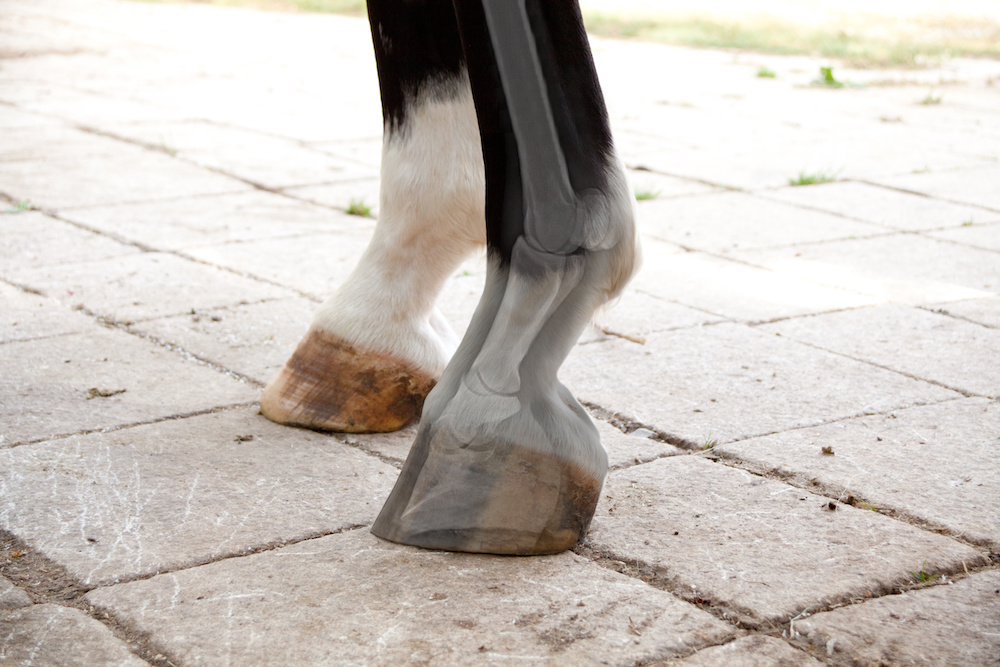
Every day veterinarians across the country see hundreds of cases of laminitis, a painful disease that affects the horse’s feet. What is especially alarming is that some cases are preventable. In fact, it may be that we are killing our horses with kindness.
Consider that a common cause of laminitis is overfeeding — a management factor that is normally within our control.
By learning more about laminitis and its causes, signs and treatments, you may be able to minimise the risks of laminitis in your horse or control the long-term damage if it does occur.
LAMINITIS DEFINED
Laminitis results from the disruption (constant, intermittent or short-term) of blood flow to the sensitive and insensitive laminae. These laminae structures within the foot secure the coffin bone (the wedge-shaped bone within the foot) to the hoof wall. Inflammation often permanently weakens the laminae and interferes with the wall/bone bond. In severe cases, the bone and the hoof wall can separate. In these situations, the coffin bone may rotate within the foot, be displaced downward (“sink”) and eventually penetrate the sole. Laminitis can affect one or all feet, but it is most often seen in the front feet concurrently.
The terms “laminitis” and “founder” are used interchangeably. However, founder usually refers to a chronic (long-term) condition associated with rotation of the coffin bone, whereas acute laminitis refers to symptoms associated with a sudden initial attack, including pain and inflammation of the laminae.
CAUSES
While the exact mechanisms by which the feet are damaged remain a mystery, certain precipitating events can produce laminitis. Although laminitis occurs in the feet, the underlying cause is often a disturbance elsewhere in the horse’s body. The causes vary and may include the following:
- Digestive upsets due to grain overload (such as excess grain, fruit or snacks) or abrupt changes in diet.
- Sudden access to excessive amounts of lush forage before the horse’s system has had time to adapt; this type of laminitis is known as “grass founder.”
- Toxins released within the horse’s system.
- High fever or illness; any illness that causes high fever or serious metabolic disturbances has the potential to cause laminitis, e.g., Potomac Horse Fever.
- Severe colic.
- Retained placenta in the mare after foaling.
- Excessive concussion to the feet, often referred to as “road founder.”
- Excessive weight-bearing on one leg due to injury of another leg or any other alteration of the normal gait.
- Various primary foot diseases.
- Bedding that contains black walnut shavings.
- Although controversial, prolonged use or high doses of corticosteroids may contribute to the development of laminitis in some horses.
RISK FACTORS
Factors that seem to increase a horse’s susceptibility to laminitis or increase the severity of the condition when it does occur include the following:
- Heavy breeds, such as draft horses
- Overweight body
- High nutritional plane (feeding large amounts of carbohydrate-rich meals)
- Ponies, Morgans, miniature horses and donkeys
- Unrestricted grain binges, such as when a horse breaks into the feed room (if this happens, do not wait until symptoms develop to call your veterinarian– call immediately so corrective action can be taken before tissue damage progresses)
- Horses who have had previous episodes of laminitis
- Older horses with Cushing’s disease
SIGNS
Signs of acute laminitis include the following:
- Lameness, especially when a horse is turning in circles; shifting lameness when standing.
- Heat in the feet.
- Increased digital pulse in the feet (most easily palpable over either sesamoid bone at the level of the fetlock).
- Pain in the toe region when pressure is applied with hoof testers.
- Reluctant or hesitant gait (“walking on eggshells”).
- A “sawhorse stance,” with the front feet stretched out in front to alleviate pressure on the toes and the hind feet positioned under them to support the weight that their front feet cannot.
Signs of chronic laminitis may include the following:
- Rings in hoof wall that become wider as they are followed from toe to heel.
- Bruised soles or “stone bruises.”
- Widened white line, commonly called “seedy toe,” with occurrence of serums (blood pockets) and/or abscesses.
- Dropped soles or flat feet.
- Thick, “cresty” neck.
- Dished hooves, which are the result of unequal rates of hoof growth (the heels grow at a faster rate than the rest of the hoof, resulting in an “Aladdin-slipper” appearance).
TREATMENT
The sooner treatment begins, the better the chance for recovery. Treatment will depend on specific circumstances but may include the following:
- Diagnosing and treating the primary problem (laminitis is often due to a systemic or general problem elsewhere in the horse’s body).
- Dietary restrictions; stop feeding all grain-based feeds and pasture. Supply more treatment supplements.
- Administering liquid vitamins if the horse is ill.
- Administering other drugs such as antibiotics to fight infection; anti-endotoxins to reduce bacterial toxicity; and anticoagulants and vasodilators to reduce blood pressure while improving blood flow to the feet.
- Stabling the horse on soft ground, such as in sand or shavings (not black walnut) and encouraging the horse to lie down to reduce pressure on the weakened laminae.
- Opening and draining any abscesses that may develop.
- Cooperation between your veterinarian and the farrier (techniques that may be helpful include corrective trimming, frog supports and therapeutic shoes or pads).
